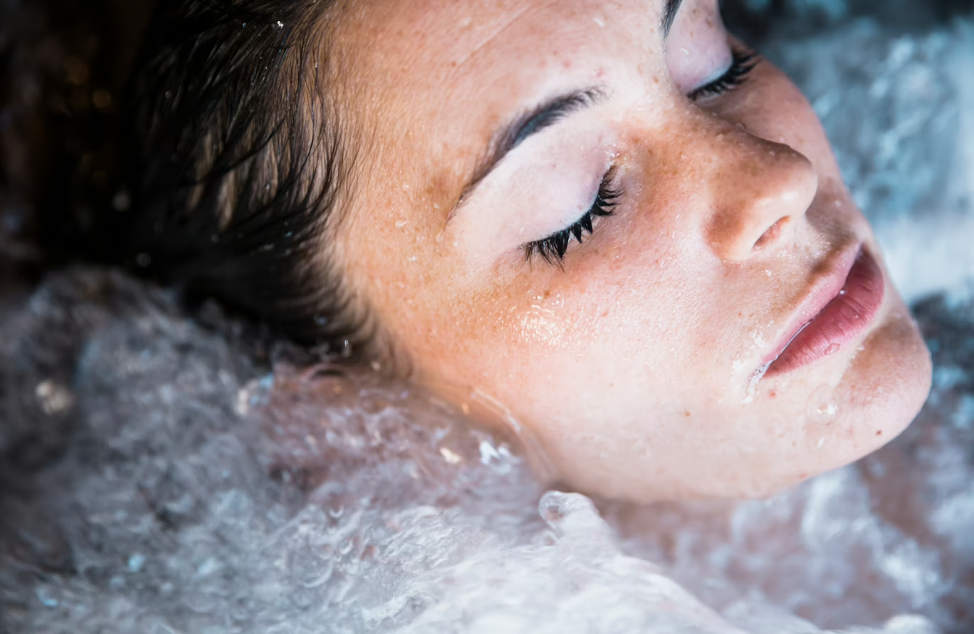Before we take the plunge and discuss the multiple ice bath benefits which cold water therapy can provide, let’s take a quick look at what an ice bath is and what you need to do with it.
What Is An Ice Bath?
Essentially an ice bath is a large container filled with ice water that is big enough to submerge your whole body up to your ears.
Get ready to be cold – but it’s worth it, we promise!
Ice bathing or cold water therapy has been around for a very long time, hundreds of years in fact, and is seeing a reemergence in popularity.
Key Benefits of Taking Ice Baths
Ice baths offer a range of therapeutic benefits through the physiological effects of cold water immersion. By lowering the skin, muscle and core body temperature, ice baths provide:
- Reduced inflammation – the cold causes vasoconstriction, reducing blood flow and swelling around tissues and joints. This decreases localized inflammation.
- Decreased muscle soreness – the cold helps numb sore muscles and reduces pain and tenderness following exercise.
- Faster recovery – with less soreness, the body can bounce back quicker between training sessions or events.
- Improved circulation – blood retreats from the extremities to the vital organs and then floods back outward. This brings nutrients that aid repair.
- Mental toughness – overcoming the extreme cold builds focus, controlled breathing and resilience.
- Weight loss – the body burns extra calories warming back up after an ice bath.
- Immunity boost – cold exposure activates the immune system and anti-inflammatory proteins.Stress relief – The adrenaline rush and mindfulness involved can help decrease stress.
While most sessions last 5-15 minutes, prolonged exposure can cause hypothermia. But used properly, ice baths provide a wide range of therapeutic benefits for recovery and health through the physiological response to cold water immersion.

Cold Water Therapy – A Brief History
The use of cold water for therapeutic purposes dates back centuries, with records of cold bathing practices found in ancient Greek, Roman, Japanese, and Egyptian cultures.
- In ancient Greece, bathing in natural cold springs and frigid waters was prescribed for health, while the Romans also advocated cold baths and swims to fortify the body. The samurai warriors of medieval Japan used cold water immersion to develop mental strength and discipline.
In the 17th and 18th centuries, medical interest in water therapies resurged in Europe. Hydrotherapy clinics opened that promoted healing cold baths and showers. The therapeutic use of water spread to the U.S. by the mid 1800s as well. The philosophy of “cold hardening” became popular, toughening the body through cold exposure.
- In the 1960s-70s, German athletes began submerging in ice baths to reduce inflammation and speed up recovery. Use spread across sports from runners to rugby players to American football teams as evidence of performance benefits grew.
Today, forms of cold water therapy like ice baths, cold showers, and cryotherapy chambers remain popular for sports recovery, pain relief, mood enhancement, and general wellness. The once archaic practice has proven medical benefits that keep the use of cold in healing relevant in the modern age.
Though the methods have evolved, the underlying premise of stimulating the body through cold stress to induce restorative and strengthening reactions remains largely the same as in ancient times. The therapeutic power of frigid water endures.
Choosing An Ice Bath – Size Matters!
Get a bath big enough to submerge up to your ears.
There are a few reasons why it is recommended to expose your neck to the cold water during an ice bath:
- Cool the carotid arteries – The carotid arteries run up either side of the neck and supply oxygenated blood to the brain. Cooling these major arteries helps reduce overall body temperature quickly.
- Cool the vagus nerve – The vagus nerve extends into the neck and helps regulate heart rate and other involuntary functions. Cooling the vagus nerve can help lower heart rate.
- Increase tolerance – Exposing more skin to the cold water makes the ice bath feel significantly colder. This increased discomfort forces you to control your breathing and can improve cold tolerance over time.
- Access the lower body – Submerging the neck allows your entire body below the head to be in the ice bath. This exposes more muscle tissue to cold temperatures.
- Avoid frostbite – The neck has thinner skin and is more prone to frostbite. Limiting neck exposure to 10-15 minutes reduces this risk while still gaining the full effects.
So in summary, exposing the neck allows for more cold thermoregulation benefits and greater mind-body control during the ice bath. But care should be taken not to over-expose the delicate neck area to freezing temperatures.
Are Ice Baths Dangerous?
Ice baths can be safe and beneficial when done correctly, but there are some risks to be aware of. Here are some potential dangers of ice baths:
- Hypothermia – If you stay in too long, the cold water can lower your core body temperature excessively and cause hypothermia.
- Frostbite – The extremities, like fingers, toes, ear lobes, etc. can suffer frostbite damage from the freezing water.
- Limit ice baths to 10-15 minutes to reduce the risk of frostbite or hypothermia.
- Nerve damage – Extreme cold can damage nerves. Those with diabetes, chronic illnesses, or nerve disorders should avoid ice baths or consult a doctor first.
- Heart shock – The sudden plunge into freezing water triggers a gasp reflex that can cause cardiac arrest in susceptible individuals. Check with your doctor if you have any heart conditions.
- Infection – Bathing in unclean water can introduce bacteria into open wounds or scrapes. Use only sterile water and keep the bath clean. See the manufacturer’s cleaning instructions.
- Allergic reactions – Some people may discover allergies to the temperature extremes or additives in the bath water. Do a patch test first.
To reduce risks
- Check with your doctor before starting, especially if you have medical conditions
- Monitor the temperature and limit time in the bath
- Warm up gradually afterward and hydrate well
- Keep the water sterile and the tub clean
If taken carefully under guidance, most healthy individuals can benefit from and tolerate ice baths well. However uncontrolled use can be dangerous. Consult a physician if unsure.
The key is creating a very cold but controlled environment that elicits therapeutic benefits without dangerously freezing. Start conservatively and work up to longer ice baths as tolerated.
Conclusion
If you fancy the idea of an ice bath then here are the main points to consider before making any purchases.
Overall, ice baths can be an extremely beneficial addition to an active lifestyle when used correctly and safely. The cold water immersion provides both physiological and mental improvements that aid in exercise recovery, performance, and general well-being. Athletes in particular can experience reduced muscle soreness, faster bounce-back between training sessions, increased circulation, and improved mental toughness over time.
However, ice baths do require some caution. Creating the proper cold temperature, limiting exposure, warming up properly afterward, and monitoring for any negative reactions are all crucial to gaining advantages while minimizing potential dangers like hypothermia and frostbite. Consult a doctor before use if you have any medical conditions.
Provided you educate yourself on their proper use and take the necessary precautions, buying a tub and supplies for home ice baths can be a worthwhile investment. The benefits for recovery and training simply outweigh any inconvenience of setup. Just be sure to research thoroughly and start slowly at first. With smart use, ice baths can become an integral part of an active, healthy lifestyle.
FAQs
Here are some frequently asked questions about ice baths and their answers:
Q: How cold should an ice bath be?
A: Ideal ice bath temperature is between 50-59°F (10-15°C). This is cold enough to provide benefits but not so freezing as to be dangerous.
Q: How long should you stay in an ice bath?
A: 10-15 minutes is recommended for most healthy adults. Athletes may work up to 15-20 minutes. Never stay in longer than 20 minutes due to the risk of hypothermia.
Q: When is the best time to take an ice bath?
A: Ice baths are most beneficial within 30 minutes after intense exercise when inflammation and metabolism are high. Post-exercise is prime time.
Q: Is it safe to take ice baths daily?
A: Daily ice baths are not recommended. Too much cold exposure can lead to chronic muscle tensing and weakened immunity. 2-3 times per week is sufficient.
Q: Do ice baths help build muscle?
A: No, ice baths do not directly build muscle. But they can help speed recovery between strength sessions, allowing you to work out harder more often.
Q: Can I get the same effect from an ice pack?
A: No, localized ice packs cannot achieve the whole-body effects of chilled water immersion. Ice baths impact the entire circulatory system.
Q: Who should not do ice baths?
A: Those with heart conditions, diabetes, nerve disorders, or cold allergies should avoid ice baths or first consult a doctor.















